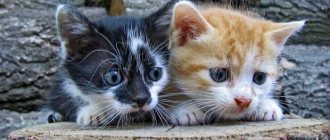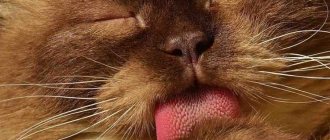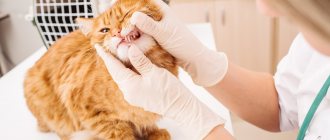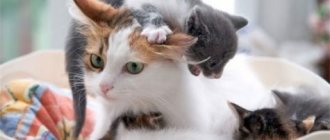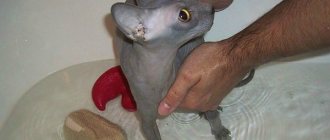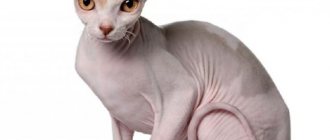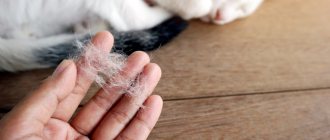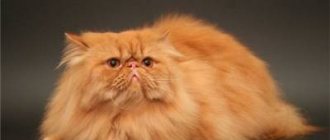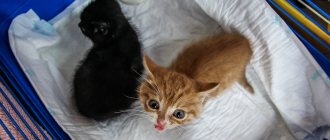Fur in a cat's stomach: symptoms
Signs of fur in a pet's stomach vary: from mild discomfort to serious problems with stool. Symptoms of illness:
- frequent constipation, problems with nutrition due to clogged intestines;
- change in the color characteristics of wool;
- decreased immunity;
- lethargic and sleepy state;
- the appearance of bloating, constant attempts to burp;
- cough.
The cat has a stomach ache due to gastrointestinal blockage
If there is fur in the body, owners often examine the kittens' teeth. If there are wool clots on the enamel, it means that some of them have entered the stomach. In such cases, you should urgently consult a doctor.
Signs of hair buildup
Accumulating in the stomach, fluff forms trichobezoars - hair stones or balls of fluff. Long-haired cats suffer from this more often.
There are symptoms that make it easy to understand that your pet has accumulated fur in his stomach, causing him severe discomfort:
- the animal has frequent vomiting, regurgitation especially after eating;
- the cat bends down to the floor, retracts its neck, coughs, and cannot regurgitate the contents of its stomach;
- dry cough, without reason;
lack of appetite;- hairballs are found in the vomit;
- lethargy;
- constipation;
- frequent unsuccessful urge to defecate;
- dullness of fur.
These signs of a clogged stomach indicate that your pet needs help to relieve the condition.
What is the reason for the appearance and accumulation of hair in a cat’s stomach?
How to remove fleas from a cat at home
Cats themselves are fairly clean pets that take care of their fur on their own. To do this, they regularly use their language. Cats lick their fur, after which the plucked hairs fall into the oral cavity and then into the stomach. If the clump turns out to be small, it will easily leave the body after going to the toilet. In opposite cases, the wool gets stuck in the stomach and interferes with its stable functioning.
What is hair accumulation in a cat's gastrointestinal tract?
During the washing process, the cat's rough tongue catches some hairs and swallows them. They consist of dense keratin, which is poorly digested in the gastrointestinal tract. The hairs, together with protein, mucus and other substances, form dense formations resembling stones - trichobezoars. They can be located in various parts of the gastrointestinal tract (GIT) and cause discomfort to the cat.
A large trichobezoar is usually removed surgically.
The most common breeds that have this problem include:
- Maine Coon;
- Persian cat;
- Turkish Angora;
- American Longhair;
- Cymric;
- British Longhair;
- Neva Masquerade;
- Norwegian forest
Unfortunately, not only long-haired cats are susceptible to this problem. I have two pets at home: a half-Persian with long hair and a Sphynx. The hairless cat loves to lick her furry friend, as a result of which she also swallows individual hairs. This, in turn, causes the development of trichobezoars in the Sphynx's stomach. In order to prevent such a situation, it is necessary to wean the cat from helping the cat wash itself.
Photo gallery: long-haired cat breeds
Persians have thick fur and a fine undercoat.
The Maine Coon's coat is very long, which makes it more likely to swallow
Neva Masquerade is prone to frequent shedding
The British Longhair cat also suffers from trichobezoars
What is dangerous about the accumulation of hair in the stomach and intestines of a pet?
Wool, accumulating in the digestive tract of a pet, can cause the development of serious diseases. This is directly related to the fact that the cat cannot remove most of the fur on its own (a small amount is removed by vomiting). The most common complications include:
- Gastrointestinal dysfunction. Trichobezoars are not digested and are not broken down by enzymes of the stomach and intestines, which leads to the development of dyspeptic syndrome (vomiting, diarrhea, gas formation).
- Intestinal obstruction. If hairballs block one part of the digestive tract, a life-threatening condition develops. The obstruction is accompanied by severe pain; the cat cannot fully go to the toilet. Such intestinal damage can lead to necrotic changes in the mucous membrane and subsequent blood poisoning.
- Development of gastritis. When a trichobezoar is in the stomach, it constantly secretes a large amount of gastric juice rich in hydrochloric acid enzymes. They do not damage the stone, but contribute to the formation of pathological changes in the gastric mucosa.
Symptoms of the development of the disease
During the first few weeks, the accumulation of fur in the cat's digestive tract occurs without clinical manifestations. After the formation of large trichobezoars, attentive owners notice the following symptoms:
- Changing the cat's behavior. The furry pet refuses to eat, sleeps a lot, practically does not play, and prefers to hide in inconspicuous places. Some animals can become aggressive: in response to an attempt to caress or stroke them, they attack a person, which is a manifestation of a protective instinct.
- Sickly appearance. The cat's previously smooth and fluffy fur falls out in clumps and looks dirty and unkempt. The claws begin to peel off, the whiskers break. In case of prolonged refusal to eat, the animal’s body becomes painfully thin: bone protrusions are sharply outlined, the volume of muscle mass decreases. When weighed, it turns out that the pet has lost from 2 to 5% of its weight.
- Dyspeptic phenomena. The cat often vomits small balls of hair, undigested food with gastric juice. The furry baby suffers from constipation, which manifests itself in the form of a prolonged absence of feces. The feces become rocky and sometimes contain blood collections or small trichobezoars. The cat's belly increases in size, due to gas formation, rumbling and extraneous noise may be present, and drooling is observed.
- Phenomena of general intoxication. When a trichobezoar exists for a long time, it is perceived by the furry pet’s body as a foreign object: inflammation develops. It is manifested by an increase in the cat’s body temperature (dry and hot nose).
One of my friends has a Neva masquerade cat living in a private house. One day, the owner noticed her pet’s gradually rounding belly and took her to the vet, suspecting pregnancy. The doctor performed abdominal palpation and ultrasound examination for a more accurate diagnosis. It turned out that the cat had a huge trichobezoar in her stomach, which caused the development of all the symptoms. To avoid intestinal obstruction, the veterinarian decided to perform surgery. The accumulation of hair was removed from the pet's body, and the cat began to feel well again.
Video: the doctor talks about the accumulation of hair in the cat’s gastrointestinal tract
The danger of hairballs
How to remove fleas from a kitten at home
Untimely treatment of pathology leads to the following consequences:
- the hairballs fill the stomach and give the animal a feeling of fullness, causing it to refuse food. This leads to a deficiency of vitamins and nutrients in the body;
- prolonged presence of villi in the stomach leads to eating disorders, bloating and acute pain, which are difficult to relieve with painkillers;
- Long-term presence of wool in the body can cause many infections and inflammatory processes.
Removing hair clots from a cat's stomach using herbs
Foreign bodies in the body lead to a deterioration in the general condition of cats: they lose the desire to frolic and play, and develop apathy and drowsiness.
Rules for breeding wool
The cat's fur is falling out: why and what to do
Before removing fur from a cat’s stomach at home, you should familiarize yourself with the main rules of the procedure.
- At the initial stages, you can try to remove hair from the stomach using traditional methods, for example, using green grass. After eating it, the cat will vomit and the foreign body will be expelled from the body.
- In advanced cases, special foods and medications are used. In parallel with therapy, you need to monitor the cat’s food and drink. Proper nutrition and plenty of fluids will help the wool clots leave the stomach quickly;
- For long-term constipation and intestinal obstruction, use Vaseline oil orally. It helps to relieve the animal's condition and soften the feces.
If home treatments do not help remove hair, you should urgently make an appointment with a veterinarian.
Don't cough up cat hair
Kote is 2.5 years old, young, healthy, short-haired, of the “noble” breed, diet - 60 percent - canned food, 35 percent - cereals, vegetables and meat, 5 percent - live game (yes, this bitch catches birds on the balcony). He has been trying to regurgitate fur for about a month now (urging, coughing), but to no avail. I bought him special expectorant supplement pads, to no avail. At the same time, he looks normal, behaves like a real tiger, there are no visible signs of illness or weakness. The urge to vomit every 1-2 days, although there is no vomiting. What could be the problem?
Or maybe this is not an attempt to regurgitate fur, but just a cough? It looks like this in animals. You should take it to the veterinarian, it’s most likely some kind of virus that has latched on.
Well, it’s just that the cough clearly cannot continue for a month, today I’ll buy him oats, and on the weekend I’ll take him to the vet. In any case, thanks everyone for the advice.
Well, it’s just that the cough clearly cannot continue for a month, today I’ll buy him oats, and on the weekend I’ll take him to the vet. In any case, thanks everyone for the advice.
A similar cough may also be a sign that the cat has worms. And, yes, if you can take him to the vet, then it’s better to take him.
When our cat had problems with swallowed fur, he simply vomited freshly eaten food. The vet prescribed Malt paste, it makes it easier to remove hairballs, it helped instantly.
Well, I’ll take you on Saturday, of course, heh, but I’m just scared for the vet somehow, I need to ask him to put on chain mail, otherwise this scumbag tears up strangers no worse than a dog.
Maybe he ate something inedible. Mine somehow couldn’t burp for three days, didn’t eat anything, just drank a little. It turned out that the bandage with ointment was sharpened by me, two layers approximately 5x5 cm. I was just recovering from surgery and threw this matter into the trash bag without any second thought. Well I'm not poisoning
Source
How to help your pet
To understand how to help a cat spit out fur, you need to familiarize yourself with the various range of products that doctors recommend.
Paste
Specialized pastes are designed to dissolve and remove hair clots from the body of kittens. They consist of plant elements and ballast substances that penetrate the pets’ body and help regurgitate wool fibers. The paste helps restore stomach function, speed up metabolic processes and relieve inflammation. The product is mixed into the main feed once a day.
Special feed
Today, many manufacturers create special foods that help regurgitate balls of hair in the stomach. The main components of such food are oil and plant fiber. They coat the gastric mucosa, soften stool and facilitate its exit from the body. If your cat cannot regurgitate fur, what to do:
- calm the animal;
- give him the main food;
- add a small amount of special plant food and feed your pet.
If constipation occurs for several days, specialized food is used in its pure form.
Vaseline oil
Vaseline oil acts as a laxative. It softens feces and promotes their rapid exit from the cat’s body. The product is administered using a syringe. The optimal dose is 3-4 ml. To give the injection, you need to wait until the pet is in a relaxed state.
Vaseline oil for cleansing the gastrointestinal tract of a cat with blockage
Special home herb
The product is sold in many pet stores in seed form. It is recommended to germinate them at home in special pots, and then use them to regurgitate hair from the stomach of cats.
For your information! The herbal mixture is endowed with useful vitamins and minerals that normalize the functioning of the stomach.
Do cats spit up fur? How and with what to help?
76 messages
All cats shed hair from time to time, but if it happens too often, it's a warning sign.
The fur that a cat regurgitates looks like dense cylindrical hair sausages. And although the formation of dense wool formations in the stomach of cats is not a disease, this phenomenon must be constantly combated so that the trouble does not become serious.
The reason is cleanliness
Already at the age of 35 days, kittens begin to take care of themselves independently, thoroughly washing and licking themselves. Cats devote about 10% of their waking time to this activity. There are animals that are extremely clean. Self-grooming helps cats control their natural thermoregulation process, especially in hot, humid weather. Licking calms cats, helping to reduce feelings of anxiety, worry, or conflict.
Almost all breeds of cats are prone to the accumulation of hair in the stomach, even short-haired ones, since they swallow the hair when licking themselves. This problem is aggravated during the molting period, as well as in animals with thick, dense, long hair. When a cat often licks itself and drools, this may mean the following: an unfavorable environment (not very clean, noisy, etc.), high humidity and temperature, the presence of parasites.
Most cats are characterized by occasional regurgitation of fur (1-4 times a month). This is considered normal and should not be a cause for concern.
Excessive hair in a cat's stomach is indicated by:
* frequent regurgitation (a mixture of mucus and fur); * constipation or very hard stools with fur particles; * vomiting with particles of undigested food; * bloated belly; * dry, matted coat; * intermittent and dry cough, usually after eating; * lack of appetite; * depressed state.
Regular brushing. The more dead hairs on a comb or brush, the less will be in the cat's stomach. This procedure should become regular - about once a week, and during molting - daily.
Professional food - a special formula for hair removal with a high content of plant fibers provides a complete, balanced diet and helps the natural removal of hair from the body. The food can be given separately or mixed with daily food.
Hair removal paste - contains malt syrup, mineral oil and lecithin, which have a positive effect on the digestive system.
Water is necessary for digestion. To improve its daily consumption, you can purchase an automatic drinker with an aquafilter and a constant circulation mode. The water in such a device is always clean, fresh and cool.
The cat cannot regurgitate fur - paste, food and Vaseline oil do not help
26.02.17 11:57
My Balinese is 16 years old. About 5 years ago I started having problems with fur regurgitation. We took her phytomins to remove wool and there were no problems. 2 months ago we had surgery to remove breast tumors and also removed the uterus and ovaries. Doctors forbade giving vitamins. And soon the problem with regurgitation recurred. He coughs and tries to burp, but to no avail. We bought malt and gave the paste for 5 days, at first my appetite improved, but then everything happened again. Now he eats very little and refuses even his favorite treats. Although the interest in food remained. The state is sluggish. They gave her Vaseline oil and she pooped, but without hair. I ate a little. I can take you to the doctor only in three days. What can you do now?
re: Cat cannot regurgitate fur - paste, food and Vaseline oil do not help
26.02.17 12:14
Your assumption that the condition is associated with a bezoar may be wrong. Of course, you should see the doctor earlier. Don't let your cat go hungry. If he refuses, you can try feeding him diluted baby food (without salt and spices) from a syringe without a needle. Examine your cat's mouth to see if there are any wounds or ulcers.
re: re: Cat cannot regurgitate fur - paste, food and Vaseline oil do not help
26.02.17 12:21
Of course, this is also possible, but in the past the picture was exactly like this. She doesn’t completely refuse to eat, it’s clear that she wants to, but she eats very little. What could it be? And most importantly, how to help her before going to the doctor?
re: re: re: The cat cannot regurgitate fur - paste, food and Vaseline oil do not help
26.02.17 13:45
When operating on a 16 year old cat, what examinations were performed before the operation? ECHO of the heart, blood biochemistry, general blood test, radiography in 3 projections? Brave and courageous Uzbek veterinarians, given their qualifications. It can be anything. And besides assisted feeding and independent droppers subcutaneously in the withers area, perhaps with the addition of vitamin B12, so as not to harm - it is impossible to do and guess what is wrong with the cat. Check to see if the cat is still coughing or vomiting (with nausea). From your description, it’s not clear what it means to cough while trying to burp? Regurgitation is not an active act at all; no one tries to do anything before it. Check your symptoms. Cough or vomiting?
re: re: re: re: The cat cannot regurgitate fur - paste, food and Vaseline oil do not help
27.02.17 02:46
No analyzes were performed. The same as ultrasound or ECHO. The operation was urgent because the infection began to fester very quickly. After the operation, Metrogyl was dropped for two days. I was injected with ketonal and cefazolin for three days. She recovered quickly for her age. But we began to notice that I began to drink water. Although this has not happened before. The appetite was increased. She walked around begging for food, which is also not typical for her. And as for vomiting and coughing. She always vomited fur very heavily. Before taking phytomins, it often happened that fur got stuck in the throat and had to be pushed through with a finger. I could sit for several minutes and seem to hiccup and only then vomit. Now it looks as if she is trying to say - Hiiii but there is no discharge from the nose or mouth. In the morning we found some vomit. Without bile and mucus, just chewed food. She pooped very sparingly. And she ate everything that was left on her plate overnight.
Recommended products for treating and removing hair
Veterinary pharmacies sell special complexes that contain herbal ingredients and help cleanse the stomach of pets.
Phytocomplex "Nature"
Vitamin plant complex "Nature" contains ballast components, milk sugar and malt. These components normalize the acid-base balance of the intestines, forming a belch, which rids the kitten’s body of a foreign body. The tableted product is added to food or given to the animal in its pure form.
Prophylactic mixture "Nutri-Vet"
The drug consists of omega-3 acids, vitamins and beneficial macroelements. They enrich the stomach with nutrients and relieve it from further blockages. The mixture is used 1-2 times a day as an additive to food or as an independent preparation. She helps the cat regurgitate foreign matter.
Beaphar Bits Mix
The beneficial pads contain malt paste, which helps cleanse the digestive system and remove foreign objects from the intestines. The products are allowed to be used for preventive purposes. The pads are considered to be a universal remedy, as they are suitable for newborns and adult pets.
Important! In addition to their cleansing properties, they have an immunostimulating effect.
Vitamin supplement
The drug consists of vitamins E, omega-3 acids and fatty plant components. These substances have a laxative and cleansing effect, normalize metabolic processes and restore the functioning of the gastrointestinal tract. The additive is used during pathology, as well as for preventive purposes.
Cliny
Cliny spread consists of malt extract, fiber and corn oil. These components normalize digestion, improve appetite and help soften stool.
Paste for removing hair from a pet's body
Vitamin complex Malt-Kiss
A fortified product containing malt and ballast substances. The product restores the acid-base balance of the stomach and promotes the rapid release of hair clots from the body.
Dry food
Dry food is no less popular in the fight against pathology. They contain useful macroelements, minerals and vitamins that normalize the functioning of the digestive system.
Purina Cat Chow Special Care Hairball Control
Dry food for removing hair from cats and cats is intended for adult pets. The product has a positive effect on gastrointestinal motility, which helps pets regurgitate fur. The composition includes vitamins, minerals and plant substances.
Hill's Science Plan Feline Adult Hairball Control
A product designed to remove hair from the digestive system. Contains antioxidants, minerals, fiber. The substances have a cleansing and laxative effect.
Savarra Adult Cat Hairball Control
Dry food helps restore the functioning of the digestive system and cleanse the gastrointestinal tract of foreign bodies. The composition includes turkey meat, flax seeds, herbal ingredients. The products are recommended for use in feeding adult cats.
Gimpet Malt-Soft
The product is designed to remove hair from the cat's body. The food is designed for adult pets. It contains plant substances, vitamins and minerals. They regulate the functioning of the gastrointestinal tract and have a preventive effect.
Kittymalt Hairball Remedy Paste, 8 in 1 Excel
The drug contains mineral oils, malt syrup and vitamin E. It has a tonic and laxative effect on the body, helping to remove foreign elements from it.
Pet care
It is worth remembering the rules for caring for your cat during therapy. If the cat cannot regurgitate fur during treatment, what to do and how to remove it:
- provide the animal with plenty of fluids with added oils;
- comb the cat's shedding fur so that she does not do it on her own and does not expose her intestines to another blockage;
- Monitor your pet’s diet and feed it food containing plant components. Such food helps to fill up and enrich the intestines with useful substances.
To avoid infection, it is recommended to monitor your cat's hygiene.
Preventive measures
To avoid re-clogging, doctors advise using special pastes and mineral supplements during shedding. This product helps remove villi from the stomach in a short time by stimulating regurgitation. In addition, it is worth adding food rich in sulfur, magnesium, and folic acid to your cat’s diet.
Hairballs in a cat's body are a common problem that animals encounter during the shedding process. A timely response to pathology on the part of the owner helps prevent the development of complications and the inflammatory process.
How to remove fur from a cat's stomach
In order to effectively and competently remove excess hair from the stomach, there are quite a large number of methods. The main ones will be given below. However, this does not mean that you have to do treatment yourself. Only an experienced veterinarian is able to prescribe the course of treatment and the timing required.
in which it must be adhered to so that the illness passes as quickly as possible and without consequences for the pet.
This also guarantees a complete recovery and, perhaps, the doctor will allow the owner to use this method even when the symptoms recur . However, this is still not recommended and it is better to call the veterinarian at home once again to be sure that this is the correct diagnosis and there are no complications.
